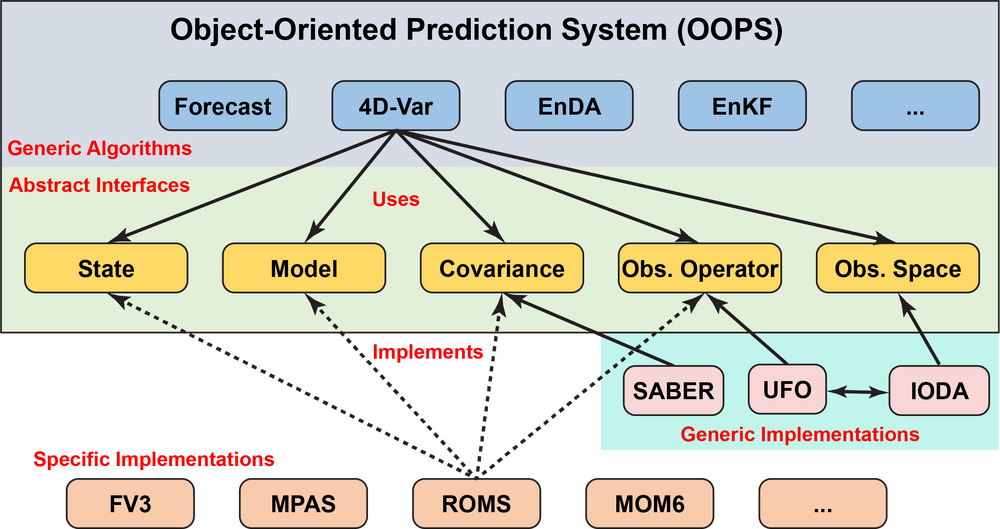Difference between revisions of "ROMS-JEDI Intro"
Tag: Reverted |
Tag: Manual revert |
||
| Line 20: | Line 20: | ||
The '''ROMS-JEDI''' framework is intended for users interested in ocean prediction and data assimilation. Currently, we use the '''JEDI''' framework to incorporate physical observational data into regional '''ROMS''' applications using variational ('''3DVar'''/'''4DVar''', '''3D-FGAT'''/'''4D-FGAT'''), ensemble ('''EDA''', '''EnKF''', '''LETKF'''), and hybrid ('''3DEnVar'''/'''4DEnVar''') data assimilation methodologies. The '''ROMS''' Tangent Linear Model ('''TLM''') and Adjoint Model ('''ADM''') kernels are used in the '''4DVar''' family of algorithms. | The '''ROMS-JEDI''' framework is intended for users interested in ocean prediction and data assimilation. Currently, we use the '''JEDI''' framework to incorporate physical observational data into regional '''ROMS''' applications using variational ('''3DVar'''/'''4DVar''', '''3D-FGAT'''/'''4D-FGAT'''), ensemble ('''EDA''', '''EnKF''', '''LETKF'''), and hybrid ('''3DEnVar'''/'''4DEnVar''') data assimilation methodologies. The '''ROMS''' Tangent Linear Model ('''TLM''') and Adjoint Model ('''ADM''') kernels are used in the '''4DVar''' family of algorithms. | ||
Revision as of 04:56, 31 August 2023
| ROMS-JEDI Menu |
|---|
| 1. Introduction |
| 2. Compiling |
| 3. Implementation |
| 4. Observations |
| 5. Unit Test Cases |
Introduction
The Joint Effort for Data Assimilation Integration (JEDI) framework is a unified, high-level, state-of-the-art data assimilation (DA) system for scientific exploration and operational forecasting. The diagram above shows that the JEDI building blocks are model agnostic, and any modern geophysical numerical kernels can be interfaced. Its separable generic design and abstraction allow the implementation of various DA methodologies, including variational, ensemble, hybrid, and coupled approaches that are common to any geophysical system, without the need to develop such algorithms separately for each model technically. The JEDI framework is centered around the Object-Oriented Prediction System (OOPS) layer classes and operators implemented in C++ using templates. The specific implementations like ROMS-JEDI are written in Fortran 2003 because of the need for class objects, polymorphism, inheritance, and interoperability between C++ and Fortran. The interoperability binding allows Fortran to invoke C++ functions and vice versa C++ to invoke Fortran procedures.
The JEDI separation of concerns design allows the incorporation of diverse (current and future) observational data streams essential for any DA system. Observation operators can be efficiently coded and added to the Unified Forward Operator (UFO) interface, which simulates, interpolates, and relates observable data to the model component state vector, H(x). The UFO interface also implements quality control, data thinning, and bias correction. The Interface for Observation Data Access (IODA) storage layer ingests observational data from providers into the UFO and OOPS building blocks. The immense amount of incoming data can be trimmed down, quality-controlled, and filtered by UFO operators before it is assimilated and during postprocessing when computing diagnostics, impacts, and sensitivities.
The ROMS-JEDI framework is intended for users interested in ocean prediction and data assimilation. Currently, we use the JEDI framework to incorporate physical observational data into regional ROMS applications using variational (3DVar/4DVar, 3D-FGAT/4D-FGAT), ensemble (EDA, EnKF, LETKF), and hybrid (3DEnVar/4DEnVar) data assimilation methodologies. The ROMS Tangent Linear Model (TLM) and Adjoint Model (ADM) kernels are used in the 4DVar family of algorithms.

